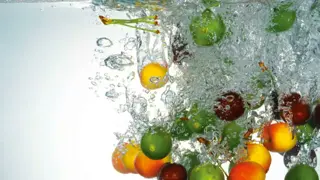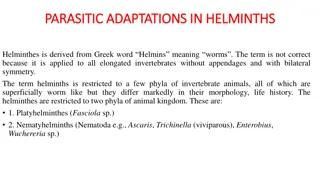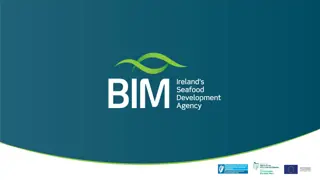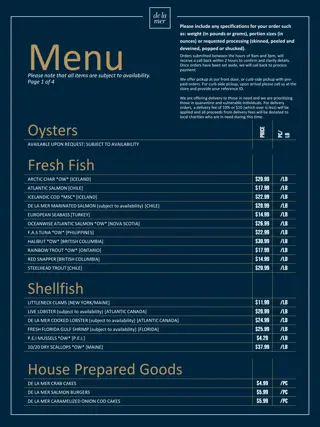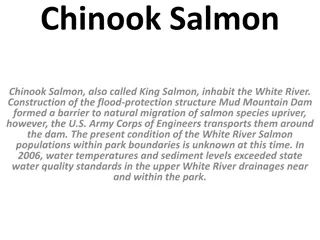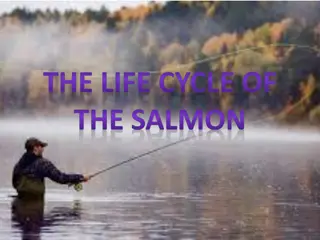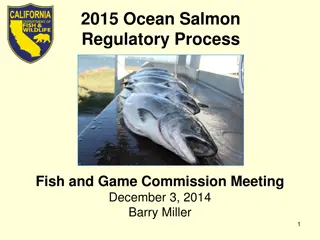
Life Cycle of Atlantic Salmon in Miramichi River
The life cycle of Atlantic Salmon in Miramichi River involves different stages such as eggs, alevins, fry, parr, smolts, and adult stages like grilse and large salmon. The process includes spawning in shallow, rapid areas, hatching of eggs, development into alevins, emergence as fry, growth into parr, migration to sea as smolts, and maturing into adult salmon. This cycle showcases the fascinating journey of Atlantic Salmon in their natural habitat.
Download Presentation

Please find below an Image/Link to download the presentation.
The content on the website is provided AS IS for your information and personal use only. It may not be sold, licensed, or shared on other websites without obtaining consent from the author. If you encounter any issues during the download, it is possible that the publisher has removed the file from their server.
You are allowed to download the files provided on this website for personal or commercial use, subject to the condition that they are used lawfully. All files are the property of their respective owners.
The content on the website is provided AS IS for your information and personal use only. It may not be sold, licensed, or shared on other websites without obtaining consent from the author.
E N D
Presentation Transcript
Atlantic Salmon MIRAMICHI on the Katie Wallace, Julianna Hache, Luc Richard, Kayla Arseneault
Eggs: The Atlantic Salmon seek out shallow, rapid areas of a river and its tributaries (is a stream or river that flows into a main stem (or parent) river) when they are ready to spawn. From June until October the principal runs of this anadromous fish will allow them to enter and inhabit these areas where spawning gravel is available. In late October, the female salmon will choose her spawning ground and she will dig a shallow nest called a depression or red with her tail, and she will deposit her eggs. Soon after, the eggs deposited by the female will be fertilized by the male s milt or sperm, and then covered by gravel to protect them. The newly deposited eggs will now take around 6 12 weeks to hatch Salmon Egg
Alevins: Once the eggs hatch in the spring, they become alevins. The alevins must stay in the gravel to absorb their yolk sac until around late May to early June, and then they will emerge from the gravel and begin to find food for themselves such as small insects in the stream. Alevin At this point the alevins will measure around 2-3 cm in length and are also referred as underyearling parr or fingerlings .
Fry Once the alevin absorbs all the yolk in their sac, they now have to fend for themselves when it comes to food and other aspects as well. At this point, the young salmon is called a fry. Fry will already have the necessary instincts to hide from predators, use river currents, create schools together and other survival skills. Fry
Parr: After the fry spends one year in fresh water, it are referred to as postyearling par. Most of these young salmon will spend up to three years in the freshwater stream before swimming to sea, however; the fry kept in a hatchery will go to sea after spending only one year in freshwater. Parr
Smolts: The parr will begin to migrate to sea in May or June, after reaching a length of about 15 cm and finally changing to the silvery color of a mature salmon. At this point the fish are called smolts. The fish may now live in salt water without absorbing the salt into its blood stream.
ADULT STAGES: GRILSE & LARGE SALMON
Grilse The number of years spent at sea before returning to their freshwater river to breed differs. Salmon that spend only one winter out at sea before returning to spawn are called grilse. Grilse weigh up to 2.5 kg at this time. Grilse
Large Salmon Large Salmon Salmon that spend two or more winters at sea before returning to their freshwater river to spawn are referred to as large salmon. They can way from 3.5 -12 kg, as they increase in size each migration cycle. However, less than 10 out of 100 spawning fish return to spawn again. When the adult salmon return to migrate, most grilse are males and most of the large salmon are females. The (large) female salmon releases around 7 600 eggs, only of which about 100 will survive and become smolts.
Atlantic Salmon are anandromous, which means that they migrate from the rivers to the sea. Because they are born in fresh water and they travel to salt water, the Atlantic salmon have had to adapt to their changing environments. One of the most important adaptations the Atlantic salmon has made is how they are able to go from areas with fresh water (for example, the rivers or streams they travel through) to areas with high concentrations of salt water (for example, the salt water in the Atlantic Ocean). The salmon have four sets of gills, which each have specialized cells to help them get the most oxygen out of any kind of water (fresh or salt).
Atlantic Salmon Must Adapt to their Environment: They have specific adaptations that are used in salt water and other adaptations for fresh water: One of the main adaptations is their gills. There are four sets and each gill contains specialized cells that allow them to travel between salt water and fresh water. The Lateral Line is very important. It allows salmon to detect movement in the water, whether it be other fish, or even water currents. Knowing the flow of the water is important because the salmon need to know the difference between upstream and downstream to migrate.
The design of the Atlantic salmon helps them swim fast to allow them to get away from predators quickly. It also allows them to be good predators themselves.
Osmolarity Osmolarity is the measure of solute concentration, defined as the number of osmoles (Osm) of solute per litre (L) of solution (osmol/L or Osm/L) (http://en.wikipedia.org/wiki/Osmolarity). Salmon have the ability to filter the salt water in their gills without absorbing it into the blood stream. The gills act as a gate. They are able to get the oxygen from water in and diffuse the salt out. This means the salmon s gills are very efficient at dissolving oxygen. The mouth of the salmon also allows the water to glide over the gills, making them even more efficient.
Since many different types of fish have to travel from salt water to fresh water and vice verca, the fish have become great osmoregulators. Osmoregularity is when a fish is able to control the level of water and mineral salts in its blood. All fish, including the Atlantic Salmon, that have to travel from fresh water to salt water have to go through this process. Even though the fish never have equillibrium between themselves and water around them, this process is very helpful. If the fish were unable to do this, they could die in a very short time because the high levels of salt in their bodies would be much greater than normal. The Salmon could suffer from dehydration, killing them also. In fresh water, salmon have the opposite problem. When the salt concentration is too low outside the body, the salmon can suffer from things like salt loss (when they don t have enough salt in their systems).
Other Adaptations Salmon have a Swim Bladder, which gives them natural buoyancy in water. And best of all, their vision is spectacular. They have polarized vision. Polarization is the phenomenon in which waves of light or other radiation are restricted in direction of vibration , an example being the sunlight on water. Scientists believe this may be one of the reasons why most Atlantic Salmon can find their way back to the rivers (where they go to reproduce) so easily. Salmon are also able to see considerably far distances in clear water.
The two main branches that salmon return to are the Northwest branch and the Southwest branch. Both branches flow into the Gulf of St Lawrence. Salmon travel from the sea to the river to spawn. The barrier we are focusing on is the Northwest Barrier.
Atlantic salmon come in two size groups: small salmon (less than 63cm fork length) and large salmon (greater than 63cm fork length). Small salmon spend one year out at sea before returning to the river to spawn, and large salmon spend 1-3 years at sea before returning. Large salmon can either be returning for the first time or they may have returned the year before. to the Miramichi river, so salmon counts are not completely accurate. They estimate numbers of salmon, and they depend on mark and recapture methods to get count returning salmon. They record the sizes of the returning salmon as well. It is not possible to count every single salmon that returns
Barriers Fish barriers are used to prevent fish from swimming to places where they could be put in danger. In Miramichi, we use barriers so that salmon can have a safe place to spawn.
Small And Large Salmon Population for the Northwest Barrier: 1998 - 2009 Northwest Miramichi Small salmon Cassilis Large salmon Cassilis Year 1998 1999 2000 2001 2002 2003 2004 2005 2006 2007 2008 2009 Return est. 11,550 15,740 12,690 Northwest 1,038 1,094 Return est. Northwest 7,987 8,731 1,158 924 1,442 2,153 2,718 2,182 2,910 2,447 2,636 1,354 757 290 3,570 4,386 4,579 7,809 1,937 2,786 3,522 3,848 2,665 3,384 2,178 3,049 217 280 277 983 188 339 358 417 210 365 131 222 289 387 217 202 121 186 167 262 214 166 164 206 708 456 344 595 478 723 735 469 460 8,417 6,351 9,440 5,360 5,915 7,867 2,975 315 2009 relative to 2008 -62.2% -61.7% -71.2% 40.0% 69.5% 25.6% 2009 relative to previous 5-year mean -64.0% -85.6% -54.8% -2.3% -25.1% 5.9%
3500 Small salmon Trapnets 3000 Small salmon Trapnets Small salmon Barriers 2500 Small salmon Barriers 2000 Small salmon Barriers 1500 Large salmon Trapnets 1000 Large salmon Trapnets 500 Large salmon Barriers Large salmon Barriers 0 Year 1998 1999 2000 2001 2002 2003 2004 2005 2006 2007 2008 2009 2010
Salmon Counts for Northwest Miramichifrom 1989-2009 1400 1200 Small Salmon 1000 Large Salmon 800 600 400 200 0
Northwest Miramichi Salmon Return Estimates from 1998-2009 18000 16000 14000 Small Salmon 12000 10000 Large Salmon 8000 6000 4000 2000 0 Year 1998 1999 2000 2001 2002 2003 2004 2005 2006 2007 2008 2009
Works Cited (MLA) < http://www.atlanticsalmontrust.org/learning- zone-assets/atlantic_salmon_anatomy.pdf > http://bioweb.uwlax.edu/bio203/s2009/webb_la ur/Habitat.htm http://www.seymoursalmon.com/lifecycle.php < http://www.atlanticsalmontrust.org/knowledge/s almon-facts.html > http://www2.mar.dfo-mpo.gc.ca/science/mactaquac/lcycle.html

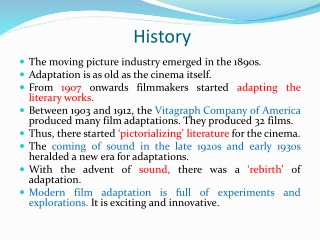
![[✔PDF✔⚡] ✔DOWNLOAD✔ Ancestral Knowledge Of Smoking Salmon: The Ultimate Gui](/thumb/68084/pdf-download-ancestral-knowledge-of-smoking-salmon-the-ultimate-gui.jpg)
